Situated near the northwestern United States, Idaho has many mountains and forests ideal for snakes, even around the Boise area. Despite this, there aren’t as many different snake species in Idaho as there are in some eastern states. Furthermore, of the 12 species of snake that call the Gem State home, only two are dangerous to humans on account of their venom.
Even though this number is small, it may cause concern for some potential hikers, since many humans have a longstanding fear of snakes. However, we don’t think this fear is warranted. The chance of injury from a snake is incredibly low, and even lower for those who know which snakes are dangerous and whether they pose a threat.
This article aims to inform people which snakes they need to watch out for, how to recognize danger, and which snakes they are more likely to encounter in the wilds of Idaho. Continue reading to learn more about some of the snakes in this state.
5 Common Snakes in Idaho
The most common snakes in Idaho include garter snakes, gopher snakes, and rattlesnakes. We’ll dive into Idaho’s two venomous snakes in a moment, but first let’s inventory up some of the most common non-venomous snakes in the state. These snakes rarely bite and pose little potential harm to people.
Gopher Snake

A gopher snake, coiled up and ready to strike.
©rawaccess/Shutterstock.com
One of the most common snakes in Idaho, the gopher snake, is also called the bullsnake because of its large size. In fact, at a whopping 67 inches, they are the largest snake in the state. They may inhabit valleys and shrublands and eat most kinds of small mammals and eggs, along with the occasional reptile.
Because of its light coloring and dark blotches, some people freak out when they encounter one in their yard, confusing it for a western rattlesnake. However, there are a few differences to watch out for. First of all, a rattlesnake will, of course, have a rattle, so if you don’t see one, you’re probably fine. Secondly, their eyes are very telling.
A western rattlesnake will have a cat-like, slit-shaped pupil when seen in the sun, while the gopher snakes’ are round. That being said, despite being nonvenomous, they have been known to headbutt or, in rare instances, bite. This venomless bite will cause no serious damage, but if you think there is even a chance that it was a rattlesnake, get medical attention as soon as possible.
Terrestrial Garter Snake
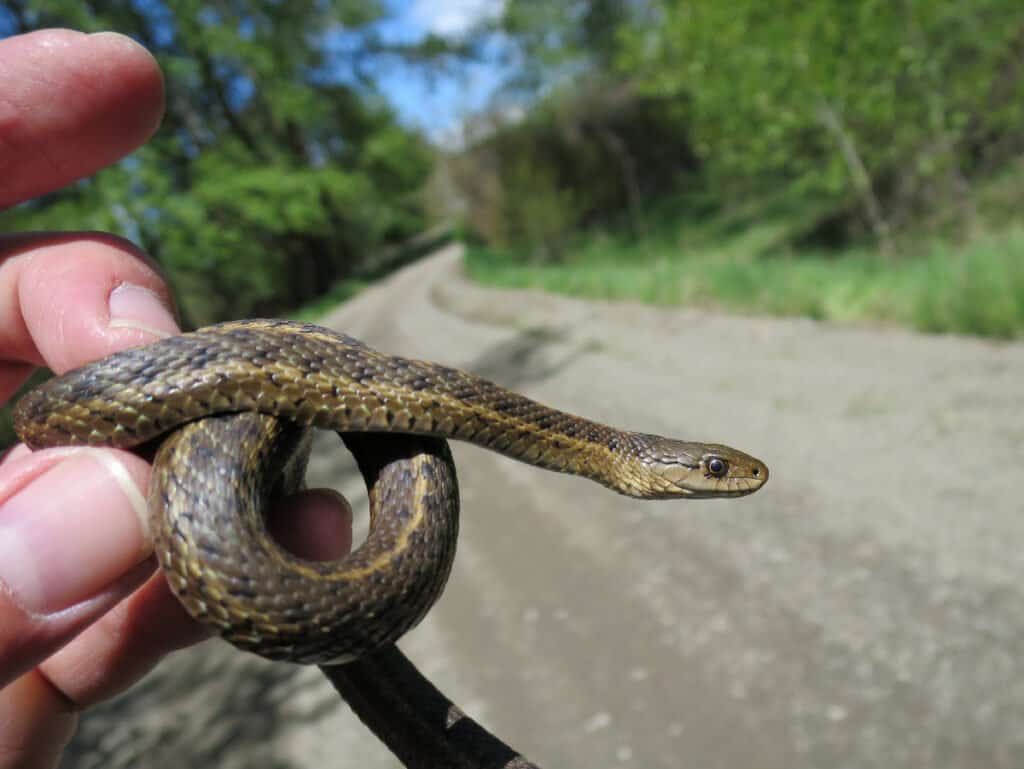
Terrestrial garter snakes are small and range across all of Idaho.
©Randy Bjorklund/Shutterstock.com
Garter snakes are the most common snake in many U.S. states, and terrestrial garter snakes make their home from the Rockies to the West Coast, including Idaho. Some people will tell you they have six different subspecies since they come in many colors, including brown, green, and black. However, this is currently up for debate in the scientific community. You’ll still find their iconic yellow, orange, or white stripes on the vast majority of adults.
Given its name, you would expect a terrestrial garter snake to make its home on land, and you would be correct. Not only do these snakes occupy grasslands and forests, but they can be found on Idaho’s high peaks up to 13,000 feet above sea level. However, did you know that they are also adept swimmers?
Part of their diet includes fish, frogs, and tadpoles, and they navigate the streams of Idaho quite well. Since their range is so wide, you will likely encounter one wherever you go. Even though they are almost always peaceful around people, their saliva does possess a weak venom that may cause swelling and irritation. It is best to get this looked at, but you need not fear for your life or limb.
Valley Garter Snake (Common Garter Snake)
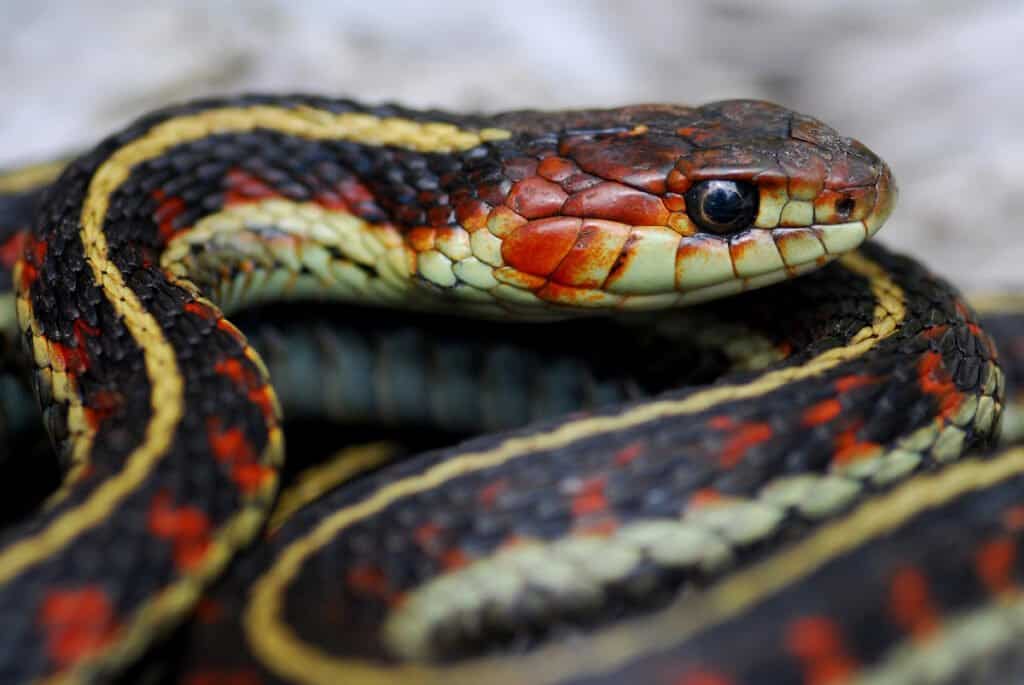
Red valley garter snakes can grow to reach 55 inches.
©Jason Mintzer/Shutterstock.com
A subspecies of the common garter snake, the valley garter snake is the dominant subspecies throughout the Pacific Northwest, including the vast majority of Idaho. They can grow to be 55 inches, have black and brown coloring, and, as you may expect, have three yellow stripes along their bodies.
In addition, this particular garter stands out with the red coloring on its head and parts of its body, along with its yellow belly. Valley garters are extremely adaptable and can be found throughout many areas of Idaho, including forests, grasslands, wetlands, and water. Like terrestrial garters, they are skilled swimmers.
Since they need to regulate their temperature, they spend much of their time under rocks and logs. In the winter, they hibernate communally in any opening, including animal burrows, rock crevices, and even manmade items. They are quite used to people and often spend time in civilized areas.
Unfortunately, this comes with a price, as they are often run over and killed out of fear, perhaps because of their color. However, there is little to fear with this snake. It is nonvenomous, and the worst thing it can do to a person is release a gross musk as an absolute last resort upon capture. Thus the valley garter snake is no more dangerous than any other garter.
Venomous (Poisonous) Snakes in Idaho
Idaho is home to two types of venomous snakes. The prairie rattlesnake has a much more limited range while western rattlesnakes are found across much of southern Idaho.
Prairie Rattlesnake

Prairie rattlesnakes are most commonly found in the Frank Church wilderness area.
©Nina B/Shutterstock.com
The prairie rattlesnake is one of two venomous snakes that reside in Idaho. This snake is common in grasslands, forests, and shrublands throughout the Midwest. However, they spend the winter in caves, crevices, or burrows and hibernate there with other snakes — not always the same species. This migration may be as much as 7 miles from their hunting grounds.
They can reach a length of 3 to 5 feet and come in many colors, including olive green, brown, and yellow. Along its body are dark blotches that turn into rings closer to the tail. Their eyes are elliptical, which means that they look like slits, similar to a cat’s eye. As a bite from this snake can be quite dangerous, it helps to be able to identify one in the wild.
That being said, the prairie rattlesnake isn’t inherently aggressive. Instead, when you enter its territory, it is likely to freeze in place in hopes of blending into its surroundings, or it may simply slither away. However, if someone is foolish enough to follow it, it will coil and rattle. This is your last chance to back off before it strikes, so please do so. This rattlesnake will not look for trouble, so avoiding it avoids any risk altogether.
Western Rattlesnake

The western rattlesnake can be found in much of western and southern Idaho.
©Tom Reichner/Shutterstock.com
The other venomous snake in the state, the western rattlesnake, is more common, as its range covers much of southern and western Idaho. The snake is also called the northern Pacific rattlesnake and can have multiple appearances. Some western rattlesnakes have a dark coloring with light blotches, and others a light color with dark blotches. In this sense, they almost look like each other’s inverse. Other than coloring, however, western rattlesnakes share most things in common. They have triangular heads, stripes from their eyes to mouths, and a length of up to 6 feet.
As far as habitat goes, the western rattlesnake is versatile. They prefer rocky areas but may also be found in grasslands. On top of that, they may be active at any hour of the day, and they can even swim. Their prey includes small animals like mice, birds, and lizards, and they curl up in wait while looking for their chance to strike.
As with most rattlesnakes, their telltale rattle is a last-ditch effort to avoid battle with a predator, so back off if you hear one. Even though most rattlesnake bites are “dry bites,” meaning that they don’t inject any venom, you don’t want to take any chances, so please seek medical attention immediately.
Before we go on to other snakes in Idaho, let’s review the five most common:
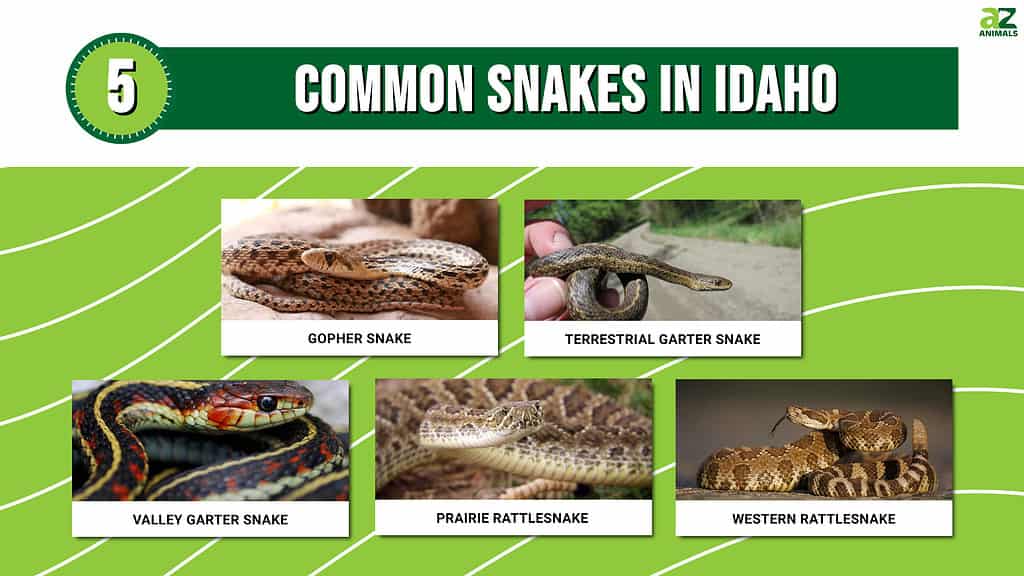
Black Snakes in Idaho
The western rattlesnake’s colorings in some individuals can be dark enough for them to fall under the category of black snake. Other snakes in Idaho that are black or have distinctive black markings include striped whipsnakes, longnose snake, and western ground snakes.
Striped whipsnakes can live in a variety of habitats but in Idaho are only present in the bottom third of the state. These nonvenomous snakes are 30-72 inches long and usually black, grey, or blueish-green with light-colored stripes along their sides. If startled or threatened, they can become aggressive and bite.
Due to their similar appearance, longnose snakes are frequently confused with the venomous coral snake. This snake has black and red markings on a yellow base and is generally 22-33 inches long. It lives in Idaho’s southwest deserts and is adept at burrowing.
Western ground snakes are small, typically 8-19 inches long, and usually have black banded markings alternating with red, brown, or orange. They are shy and only present in the southwest, mostly along the Snake River. Read more about these snakes here.
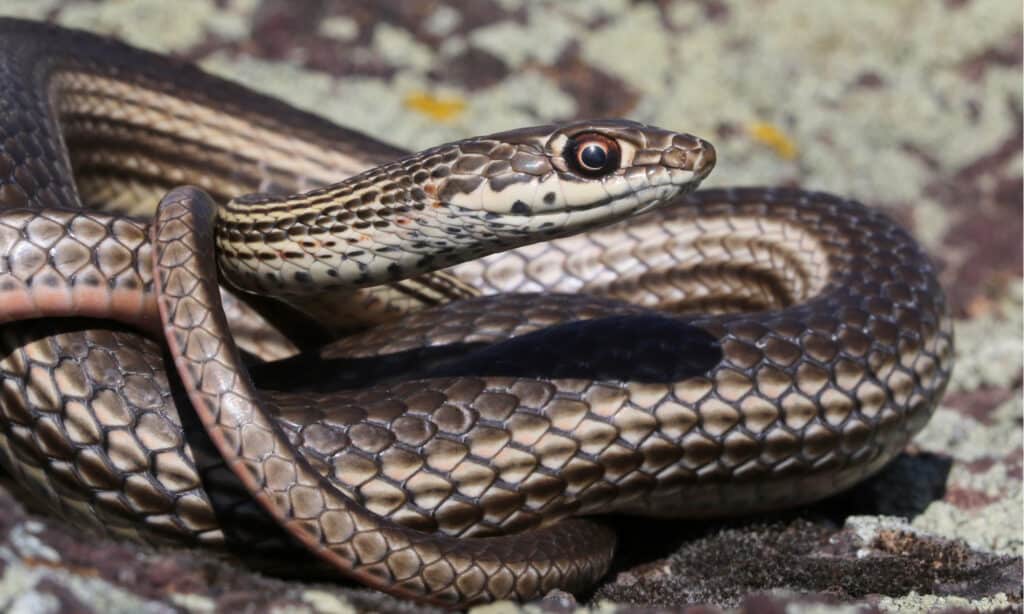
Striped whipsnakes can be found in the bottom third of Idaho.
©Randy Bjorklund/Shutterstock.com
A Complete List of Snakes in Idaho
Here is a list of every snake you’ll find in Idaho with a brief description of its range:
- Rubber boa – Ranges across all of Idaho
- Common garter snake – Ranges across all of Idaho
- Striped whipsnake – Bottom third of the state
- Gopher snake – Most of Idaho except for northern counties
- Western terrestrial garter snake – Ranges across all of Idaho
- Racer – Most of Idaho except for northern counties
- Western Ground Snake – Treasure Valley
- Night snake – Bottom third of the state
- Longnose snake – Treasure Valley
- Ringneck snake – Isolated pockets that include near I-84 on the Utah boarder and near the Washington and Oregon borders
- Western rattlesnake – Lower three-quarters of the state
- Praire rattlesnake – Central Idaho.
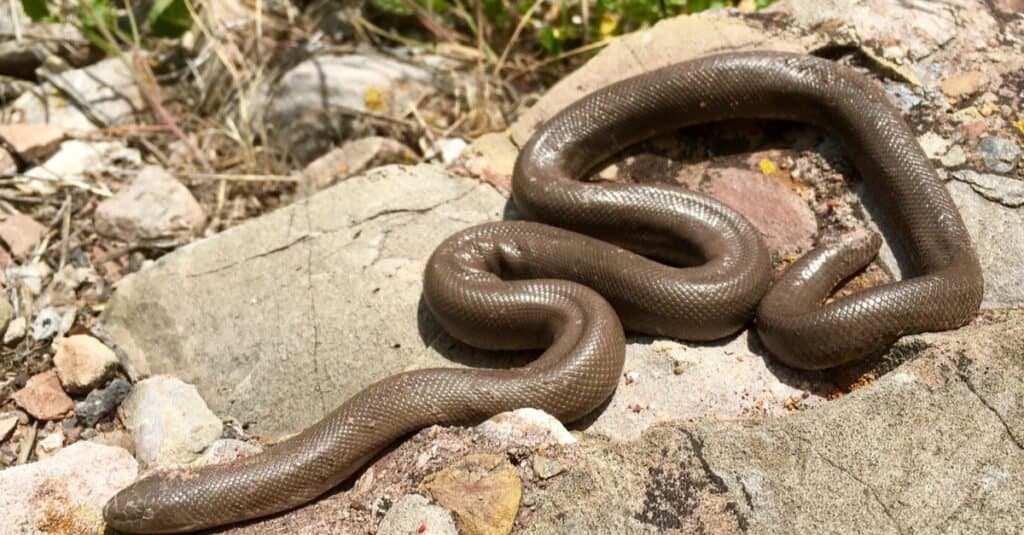
The rubber boa is one of the 34 snake species found in Idaho.
©Matt Jeppson/Shutterstock.com
In Conclusion
If you take anything away from this list, please remember that no snake in Idaho actively hunts humans. In fact, they fear them as potential predators.
They only strike back in retaliation if backed into a corner and feel that striking is their only chance at escape. So if you see or hear a rattlesnake, the best thing you can do is stay calm and leave them alone. About six people in the United States die every year from snake bites, which is remarkably low when you think about how common they are.
That being said, it can sometimes be challenging to tell all of these snakes apart from each other, and even the nonlethal ones can irritate the flesh they bite. If a snake of any kind bites you, we recommend that you seek medical attention out of an abundance of caution. However, it’s still rare to be bitten by any of Idaho’s snakes. As long as you respect your surroundings, you should have little to fear, and you can enjoy the wilds of Idaho to your heart’s content!
Summary of Common Snakes in Idaho
Here’s a quick recap of the common snakes in Idaho that we’ve taken a close look at:
| Number | Snake | Type |
|---|---|---|
| 1 | Gopher Snake | Non-Venomous |
| 2 | Terrestrial Garter Snake | Non-Venomous |
| 3 | Valley Garter Snake (Common Garter Snake) | Non-Venomous |
| 4 | Prairie Rattlesnake | Venomous |
| 5 | Western Rattlesnake | Venomous |
The photo featured at the top of this post is © Nathan A Shepard/Shutterstock.com
Discover the "Monster" Snake 5X Bigger than an Anaconda
Every day A-Z Animals sends out some of the most incredible facts in the world from our free newsletter. Want to discover the 10 most beautiful snakes in the world, a "snake island" where you're never more than 3 feet from danger, or a "monster" snake 5X larger than an anaconda? Then sign up right now and you'll start receiving our daily newsletter absolutely free.
Thank you for reading! Have some feedback for us? Contact the AZ Animals editorial team.






